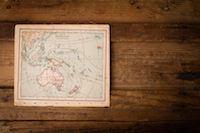 New Zealanders have long been known for their strong interest in the outdoors – getting out there, tramping, hunting, and exploring the wild, untrammeled places. There’s plenty of choice.
New Zealanders have long been known for their strong interest in the outdoors – getting out there, tramping, hunting, and exploring the wild, untrammeled places. There’s plenty of choice.
Even here in the heavily populated Waikato, we’re never much more than a half-hour’s drive from substantial patches of bush and/or a mountain where, if one is game enough to step off the main tracks, it is not a difficult matter to get lost, or at least to find places where few humans have been before you.
Mt Pirongia, the Hakarimata Ranges, the Kaimai Ranges, Rangitoto, and the Pureora Forest are good examples of great places to go lonely walkabout, on your own or with a few good friends. Further south and east there’s that great bush and mountain country of the Kaimanawa Forest Park backed by a huge block of wilderness that runs clear through the Kaweka Conservation Area, on the way to Napier. As well, there’s that wonderfully mysterious – and sometimes forbidding – country of the Urewera National Park, the Raukumara Conservation area east of Opotiki, and the Whirinaki Forest Park east of Taupo.
There’s plenty of big country in between, and every year one or several trampers or hunters get lost in some part of it – it’s big land when you’re wearing a pair of size nines, and home and tucker for the next few days are all strapped on your back.
A little further south is, perhaps, the North Island’s greatest outdoor playground and the nation’s oldest national park, the Tongariro National Park. The Tongariro Crossing, one of the country’s Great Walks, has thousands of people tramping across its 17km of magnificent landscape every year – and every year one or several people need to be rescued because of injury or lack of proper equipment.
In the South Island there are some truly awe-inspiring regions to go tramping and hunting, or even just skirting along the edges for pleasant day-walks.
The back-country of this little land of ours can be hard and harsh, with big lumps and deep valleys in it, often covered in dense bush or disorienting tussock, and with frequent streams and rivers rollicking down its slopes. It is beautiful country, but it should never, ever be taken lightly – the outdoors is what it is, and if you’re not prepared to face the hard stuff it may throw at you without notice, stay home on the couch.
Dead boring, but a lot safer.
Yet we have always been a nation of explorers, the Maori long before the coming of the pakeha, and they rapidly gained a close understanding of what were good times to go hunting, fishing, or pushing into unknown areas. And while the early European explorers largely left scant detail of their exploits, one of those who did write of his adventures was Alfred Hamish (A.H.) Reed, who migrated with his family to New Zealand when he was 11, and who went on to become a kauri gum-digger before founding the House of Reed in 1907 in Dunedin.
He was a great walker and explorer of by-ways and backcountry regions of what was then a relatively pristine land, and his books of some of his walks were, in their day, greatly prized. The first work he published was a tiny volume, hand-written in a style sometimes a little difficult to read, and illustrated with his own and borrowed photos and a number of hand drawings. He wrote it at the age of 40 while in a military camp as a soldier, specifically for his wife Isabel in Dunedin.
He was probably something of a loner, at least at the camp – perhaps because he was older than many of the other soldiers – but whatever the case, he was obviously keen on getting out into the bush and the hills and seeing just what his new land was made of.
Nearly 90 years on, a little soft-cover version of that original 124-page book was reproduced several years ago by Penguin Group (NZ), priced at $35, and bearing the rather prosaic title First Walks in New Zealand. Yet it is a delightful, whimsical little work, making light of what was undoubtedly some tough country A.H. Reed scrambled through around the Featherston area, and then beyond into the Raetihi region, the King Country and Wanganui.
Not a great deal of the land was then settled, and sometimes his walks were along roadways running through country in a process of being broken in. His tiny photos occasionally depict the stark burned trunks of trees that had been torched, and he also shows tiny settlements, or trains and other basic machinery.
The bulk of the little book concerns his five-day 200-km walk from Ohakune to Pipiriki and Jerusalem on the Wanganui River, via Raetihi, on one day covering a total of 48km.
He stayed in hotels and other accommodation along the way, and his observations of people, places and scenery are astute, concise and benign.
It’s a delightful little book, and is a pleasant reminder that simply getting out there and taking a look at the outdoors can be a very pleasant pastime.
The walkabout season is about to open again – and I’m keen to get out and do it.
Kingsley is a long-time journalist who writes a regular Outdoors column for the Waikato Times. He has published two illustrated volumes of his columns and is now working on Volume III. He can be contacted at kingsley(at)accuwrite.co.nz
Read more from Kingsley Field here










Join the Discussion
Type out your comment here:
You must be logged in to post a comment.